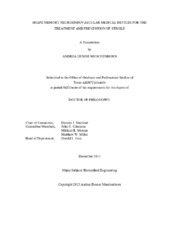| dc.contributor.advisor | Maitland, Duncan J | |
| dc.creator | Muschenborn, Andrea Denise | |
| dc.date.accessioned | 2016-05-04T13:15:50Z | |
| dc.date.available | 2016-05-04T13:15:50Z | |
| dc.date.created | 2013-12 | |
| dc.date.issued | 2013-09-26 | |
| dc.date.submitted | December 2013 | |
| dc.identifier.uri | https://hdl.handle.net/1969.1/156353 | |
| dc.description.abstract | Stroke is a cardiovascular disease that results in the abnormal blood supply to the brain either by the lack thereof (i.e., ischemia), or hemorrhage, both causing a rapidly developing loss of brain function. It affects millions of people worldwide, resulting in long-term disability and death. This work is an effort to reduce the morbidity and mortality rates associated with stroke through the implementation of shape memory materials in the design of medical devices used in its treatment and prevention.
Shape memory materials have the ability to recover predetermined deformation upon exposure to stimuli such as heat. These volume changing capabilities make them excellent candidate materials for stroke interventions. Such interventions require the accessing of blood vessels in the brain, which over the past fifty years has shifted from a direct surgical approach, to less invasive endovascular procedures.
The majority of this work is devoted to developing an endovascular thrombectomy device for the treatment of acute ischemic stroke. This device evolves from a SMP-based device into a hybrid device made of a combination of SMP foam and nitinol. The respective increase in success rate of thrombus removal in a bench-top model was from 67% to 100%. This hybrid device is then tested in a porcine model, in which it is able to restore blood flow in an artery occluded with a thrombus nearly 3 times its working length.
In addition to being utilized as a component of the hybrid thrombectomy device, SMP foam is being investigated as an embolic aneurysm filler for the prevention of hemorrhagic stroke because of its flow arresting properties. The rest of this dissertation deals with the characterization of such properties through the implementation of porous media theory. A system is constructed for the measurement of the porous media properties of SMP foam as well as coils mimicking the geometry of embolic coils, which are the state-of-the-art treatment of aneurysms. Results show that SMP foams impose a higher resistance to fluid flow compared to mock embolic coils, suggesting that aneurysms treated with SMP foams will have flow conditions more favorable for blood stasis than those treated with embolic coils. | en |
| dc.format.mimetype | application/pdf | |
| dc.language.iso | en | |
| dc.subject | Thrombectomy | en |
| dc.subject | Shape memory polymer (SMP) foam | en |
| dc.subject | Porous media properties | en |
| dc.subject | Nitinol | en |
| dc.title | Shape Memory Neuroendovascular Medical Devices for the Treatment and Prevention of Stroke | en |
| dc.type | Thesis | en |
| thesis.degree.department | Biomedical Engineering | en |
| thesis.degree.discipline | Biomedical Engineering | en |
| thesis.degree.grantor | Texas A & M University | en |
| thesis.degree.name | Doctor of Philosophy | en |
| thesis.degree.level | Doctoral | en |
| dc.contributor.committeeMember | Moreno, Michael R | |
| dc.contributor.committeeMember | Criscione, John C | |
| dc.contributor.committeeMember | Miller, Matthew W | |
| dc.type.material | text | en |
| dc.date.updated | 2016-05-04T13:15:50Z | |


